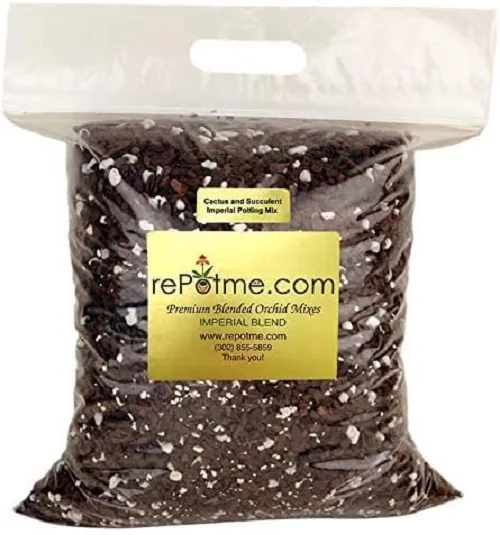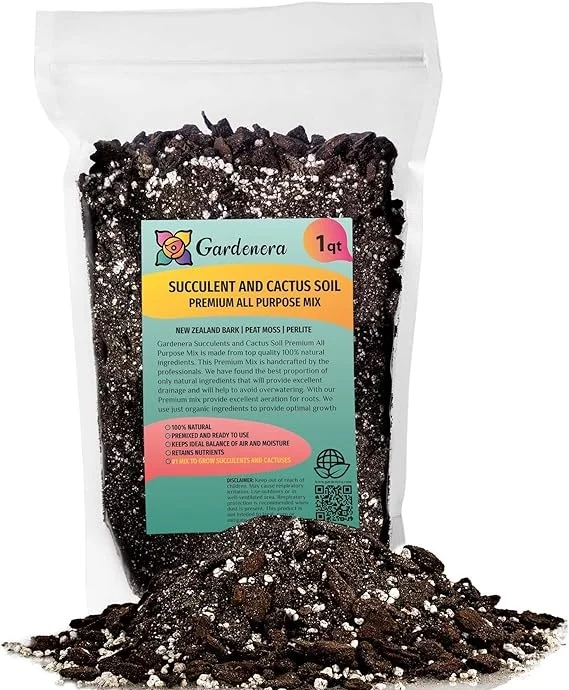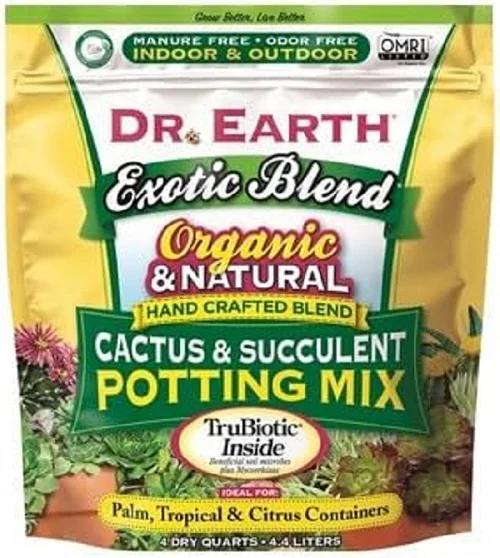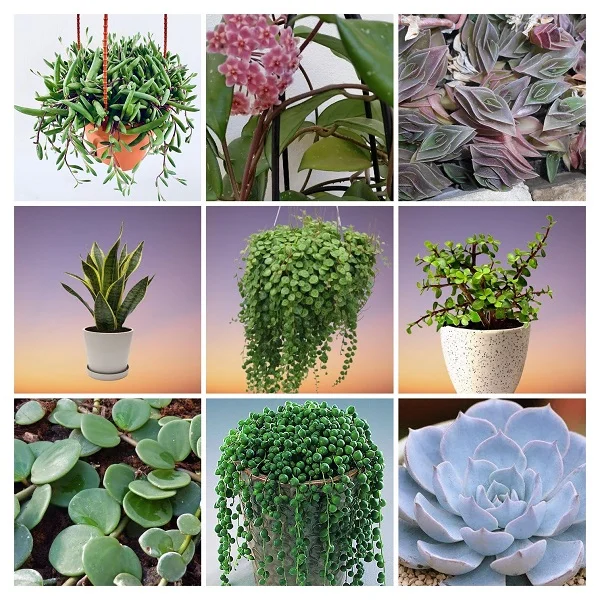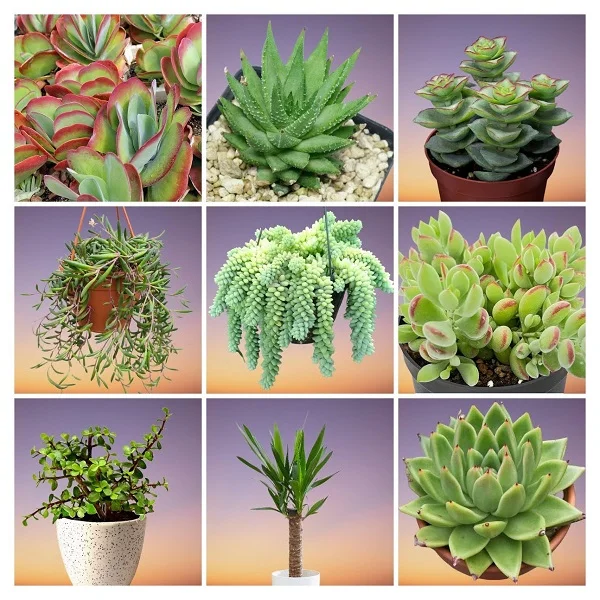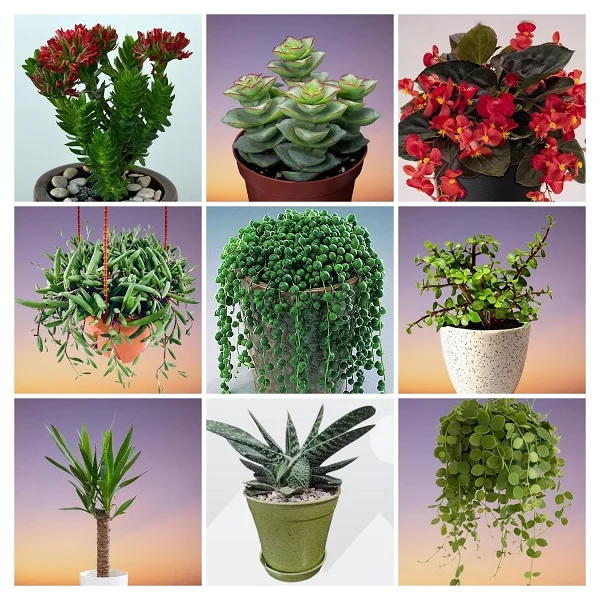Crassula capitella 'Campfire' (Red Flames Plant) Indoor Care, Propagation & Common Problems
Some links in this post may be affiliate links
Crassula capitella 'Campfire' (Red Flames Plant) thrives in bright light with some sunlight, average warmth and humidity and moderately moist, rich, well-drained soil coupled with monthly feeding in spring and summer.
Red Flames Plant is one of the perennial, succulent Crassula varieties and bears propeller-like, fleshy leaves which start off light-green and become a bright reddish color in bright light, hence, the common names, 'Red Flames' and 'Campfire Crassula'.
The leaves appear stacked on a short stem where they are larger at the base and get smaller near the top of the rosette forming floral bracts.
Campfire Crassula's fleshy leaves and stems store water which allows the plant to go for a considerably long period without being watered. This place it among the popular drought-tolerant plants for any space. Therefore, take care not to overwater this plant to avoid rotting.
The stems form roots at the internodes which take root if they come into contact with the soil and cause the plant to for a mat with a spread of upto 3 feet.
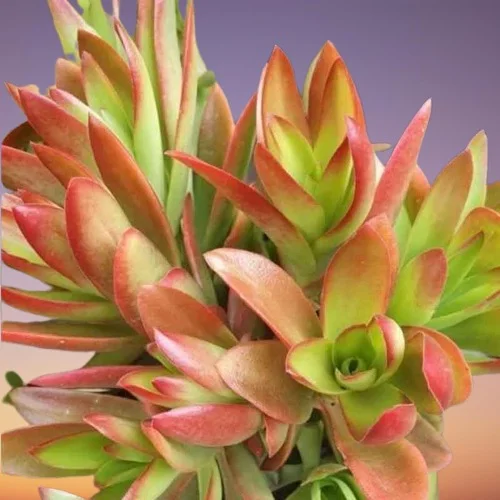
Botanical name: Crassula capitella 'Campfire'
Family: Crassulaceae
Subfamily: Crassuloideae
Common names: Crassula Campfire, Campfire Crassula, Red Flames Plant
Origin
Crassula capitella 'Campfire' is native to Transvaal Free-state and Eastern Cape provinces of South Africa and Southern Namimbia and Botswana. In its native habitat, the roots are dried and crushed into a powder which is used by the native people to heal wounds.
Flower
Crassula Campfire blooms in summer though it is unlikely to flower indoors. The flowers are small, white, star-shaped tinged with pink and form around a thick, upright stem about 6 in. tall. They attract bees and butterflies.
Size
Crassula Campfire can grow upright to a height of 1 foot and a spread of about 3 feet. On account of its compact size, Red Flames Plant like Crassula ovata (Jade Plant), Crassula picturata (Tiger Jade Crassula), Crassula coccinea (Sunglow Plant) and Crassula elegans (Elegant Crassula) is among the best plants for the limited spaces in the home or office.
Air Cleaning
Crassula Campfire is a CAM (Crassulacean Acid Metabolism) plant. CAM plants are plants that harvest Carbon dioxide at night and use it during the day to make their food.
As they make their food, CAM plants store the oxygen they produce in the process and release it at night. This is an adaptation of CAM plants to their drought-prone climate which enables then to survive the harsh climate. Therefore, having this plant in your living spaces ensures a higher oxygen concentration and cleaning of the indoor air.
Is Crassula capitella 'Campfire' toxic?
Yes. Crassula capitella 'Campfire' like its cousin, Jade Plant, is considered toxic to both humans and pets as indicated by ASPCA.
If ingested it can cause nausea, vomiting and diarrhea. Keep the plant away from the reach of children and pets.Where to Buy
Are you looking to add Campfire Crassula to your collection? You may obtain these plants online from Etsy (Link to Etsy).
How to Care for Crassula capitella 'Campfire' Indoors
To care for Crassula capitella 'Campfire' indoors, give it bright light with about 4-6 hours of direct sunlight, warmth of 15-260C, humidity of 50-55% and moderately moist, rich, loose, well-drained soil coupled with monthly feeding in spring and summer.
Campfire Crassula has no need for regular repotting as it grows best when pot-bound. Pruning is necessary to keep the plant neat, to discourage pest and disease infestations and to rejuvenate growth. Keep reading for more on these growing conditions and how to provide them.
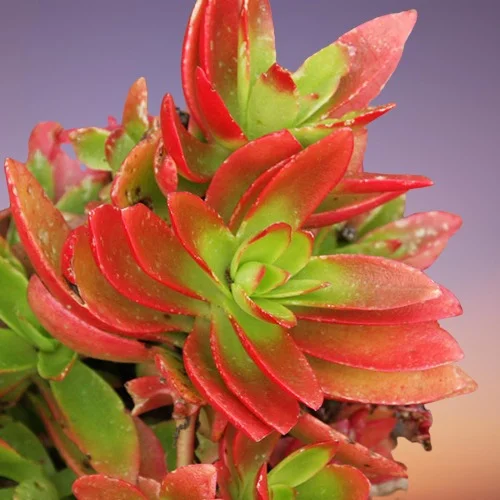
Watering
How do you water Crassula capitella 'Campfire'?
Water your Crassula capitella 'Campfire' liberally in spring and summer and allow the top half of soil to dry out between waterings to keep the soil moderately moist. Take care not to overwatering to prevent rotting, yellowing and leaf loss.
Cut down on watering in fall and winter to maintain the soil barely moist as growth is slowed at this time. Do not let the soil dry out completely to prevent wilting, drooping, yellowing and leaf drop.
Use room temperature water to prevent cold shock which can cause stunted growth and sudden leaf loss. Only water with chlorine-free water like rain water to prevent browning of leaf tips and edges.
Confirm that the pot has a drainage hole and the soil is fast-draining to avoid waterlogging as it can result in rotting and eventual death of the plant.
Be careful not to wet the foliage to minimize fungal diseases; you may water from the bottom instead.
Light Requirements
Does Crassula Campfire need sunlight?
Yes. Crassula Campfire grows best in very bright light with at least 4-6 hours of morning or afternoon sunlight. Keep it away from too hot sunshine to prevent scorching of the leaves.
If the light is not adequate, the plant will grow leggy with weak stems and small leaves. Therefore, where the natural lighting is not adequate, consider instaling a grow light to supplement it.
Rotate the pot regularly to ensure that the plant receives light on all sides for uniform growth and to prevent lopsided growth.
Should you choose to grow your Campfire Crassula outdoors, gradually acclimate it and place it in a shaded place to avoid scorching the leaves.
Temperature & Humidity
Crassula Campfire flourishes in a warmth of 15-260C in spring and summer and a minimum of 100C in fall and winter.
Keep it away from sources of drafts like windy windows and doors, AC units, hot surfaces, hot air vents and others as they can cause reduced growth and browning of leaves.
Red Flames prefers a humidity of 50-55%; it has no need for extra humidity. Make sure that there is good air circulation to reduce fungal disease infestations which are prevalent in damp still air.
Potting Soil
The best soil for Crassula Campfire should be rich in organic matter, loose and fast-draining to prevent it from getting soggy. The soil should be loose enough to allow water to drain out fast enough. Most Cactus and succulents potting soils are ideal for this plant.
Fertilizer
Feed Crassula Campfire monthly in spring and summer with a balanced, liquid fertilizer to boost a lush growth. Take care not to overfeed as the plant is a slow grower.
Do not feed in fall and winter as growth is minimal and feeding at this time can cause fertilizer burn which is characterized by browning of leaf tips and edges.
Regularly leach out excess salts by running a stream of water through the soil until the water drains through the drainage hole. Let it run for about 5-10 minutes to get rid of most of the salts.
Repotting
Repot Crassula Campfire at the beginning of the growing season (spring to early aummer), only when crowded in its current pot as it flourishes when slightly pot-bound.
Use a pot that is only one size larger than the current one to avoid overpotting. Ascertain that the pot has a drainage hole and the soil is well-draining to avoid from getting soggy soil which can lead to root-rot.
Select a clay pot as a clay pot is porous and therefore allows the soil to dry out faster which prevents it from staying wet for too long. Take a look at these terracotta pots with saucer on Amazon.
Pruning & Maintenance
Pruning Crassula Campfire involves removal of any dead or diseased leaves to keep it neat and reduce pest and disease infestations.
Cutback the bare and straggly stems at the beginning of the growing season (spring to early aummer) to rejuvenate growth and encourage a bushy growth.
Regularly clean the leaves by damp-wiping with a soft cloth to get rid of dust as well as discourage pest and disease infestations. Take care not to damage the fragile leaves.
Crassula capitella 'Campfire' Propagation
How to propagate Crassula capitella 'Campfire'?
Crassula capitella 'Campfire' is propagated from offsets, leaf cuttings or stem cuttings. The best time to propagate is at the beginning of the growing season (spring to early summer) when in active growth to promote establishment.
1. Propagating Crassula Campfire from offsets
- Carefully seperate the offset from the mother plant by cutting with a clean, sharp knife while ensuring that the offset has adequate roots.
- Fill a small pot one thirdway with a well-draining soil and moisten it slightly.
- Position the offset in the center of the pot and continue to cover the roots with the soil while firming the soil lightly. Maintain the offset at the same soil level as it was in the previous pot.
- Place the set-up in a warm, well-lit place away from direct sunlight to prevent scorching.
- Maintain good air circulation to discourage fungal diseases.
- Keep the soil slightly moist through out until the new plant is well established after which you can begin routine care.
2. Propagating Crassula Campfire from leaf cuttings
- Take leaf cuttings complete with the petiole from a healthy plant. Allow the leaf cutting to dry out (callus) for a few days to prevent rotting.
- Fill a rooting container with a fast-draining soil and wet it slightly. Ensure the container has a drainage hole to avoid rotting.
- When calloussed, lay the leaf cutting on moistsoil while ensuring that the cut end does not come into contact with the soil to prevent rotting.
- Postion the set up in a warm, well-lit place away from direct sunlight to prevent scorching of the leaf cuttings.
- Maintain the soil slightly moist through out and ensure that there is good air circulation to prevent fungal diseases.
- With time, the leaf cutting will form roots and eventually a small rosette will form at the base of the leaf cutting. This may take from 4-6 weeks.
- Allow substancial growth of the rosette before transplanting the new plant into its own pot after which you can begin routine care.
3. Propagating Crassula Campfire from stem cuttings
- Take 3-5 inches stem cuttings from a healthy plant and allow the cutting to dry out (callus) for a few days to prevent rotting.
- Fill a small pot with a fast-draining soil and moisten it slightly. Use a pot with a drainage hole to avoid rotting.
- Once callused, insert 2-3 inches of the lower cut end of the stem cuttings in the moist soil.
- Place the set up in a well-lit, warm place away from direct sunlight to prevent scorching.
- Ensure good air circulation to discourage fungal diseases.
- Maintain the soil slightly moist until the stem cuttings have rooted. Rooting may take upto 4 weeks.
- Allow substancial growth before transplanting the new plant into a pot one size larger after which you can begin routine care.
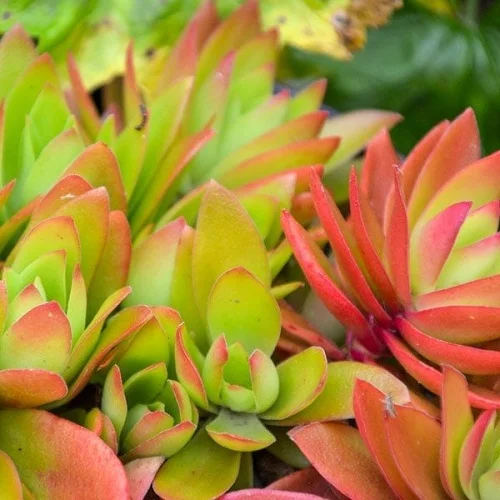
Crassula capitella 'Campfire' Problems & Remedies
Crassula capitella 'Campfire' common problems are plant dying, yellow leaves, leaf loss, pests and diseases among others. Keep reading for more on these problems and how to fix them.
Plant dying
Why is my Crassula Campfire dying?
Your Crassula Campfire is dying due to root-rot which is prevalent in soggy soil. The disease is characterized by yellowing and wilting of the leaves which is rapidly followed by browning and plant collapse.
How to fix it
- Gently, slip the plant out of its pot and inspect the roots; brown-black mushy roots indicate root-rot.
- Cut away the rotten roots and treat the healthy roots with a copper-based fungicidal solution as recommended by the manufacturer.
- Repot the plant in fresh soil and a fresh pot. Use a pot with a drainage hole and well-draining soil to prevent it from getting soggy.
- Place the plant in very bright light and stop watering for a few days to give the plant enough time to loss the excess water. After the dry period, resume routine care.
Yellow leaves
The main causes of yellow leaves on your Crassula Campfire are too little light, soggy soil, inconsistent watering, drafts, nutrients deficiency or aging.
How to fix it
Too little light: Position the plant in bright light with 4-6 hours of direct sunlight or use a grow light if you do not have enough light in your home.
Soggy soil: Use well-draining soil and a pot that has a drainage hole.
Inconsistent watering: Water when the top 2-3 inches of soil dry out but do not allow the soil to dry out completely.
Drafts: Keep the plant away from drafts coming from hot air vents, AC units, hot surfaces, windy doors and others.
Nutrients deficiency: Feed the plant monthly in spring and summer with a cactus and succulents fertilizer.
Aging: This is a natural process. As the lower leaves mature, they turn yellow, brown and eventually die.
Leaf loss
Leaf loss on Crassula Campfire is caused by use of cold water, inconsistent watering, soggy soil or cold drafts.
How to fix it
Use of cold water: Water the plant with room temperature water to avoid cold shock.
Inconsistent watering: Do not water on a schedule. Water when the top 2-3 inches soil dry out but never allow the soil to dry out completely.
Soggy soil: Use a pot with a drainage hole and fast-draining succulents soil.
Cold drafts: Keep the plant away from sources of cold drafts like AC units, windy doors, drafty windows and others.
Pests
Common pests on Crassula Campfire are mealybugs, scale insects and spider mites.
How to fix it
- Isolate the affected plant to prevent spread to the rest of the plants.
- Treat the infested plant with neem oil or insecticidal soap as per the manufacturers' recommendations on the labels.
- Check underneath and between the leaves regularly for these pests and carry out timely control measures.
- Maintain the plant well pruned and heighten humidity to depress the pest infestations.
Diseases
Crassula Campfire is prone to leaf spot disease, powdery mildew and black leg disease which are prevalent in overwet conditions coupled with poor air circulation.
How to fix it
- Isolate the affected plant to reduce spread to the other plants.
- Treat the affected plant with neem oil as per the manufacturer's instructions.
- Maintain good air flow to discourage the diseases.
- Water from the bottom to avoid wetting the leaves.
- Always allow the soil to dry out between waterings.
- Use a pot with a drainage hole and well-draining soil to prevent waterlogging.
You liked it? Share on social media.
Related Content
Amazon Associates Disclosure
Homeplantsguide.com is a participant in the Amazon Services LLC Associates Program, an affiliate advertising program designed to provide a means for sites to earn advertising fees by advertising and linking to amazon.com.
